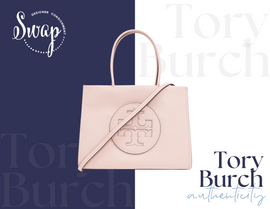Kate Spade Authenticity
Kate Spade is one of those brands that just knows how to make a statement—playful, polished, and always a little unexpected. From bold prints and eye-catching colors to classic silhouettes with a twist, the brand has carved out a well-loved niche in the fashion world. What started in 1993 with just one stylish, structured handbag dreamed up by Kate and Andy Spade has now grown into a global lifestyle label that covers everything from clothes and jewelry to tech accessories and home décor. And yet, it’s still the handbags that steal the show.
Over the years, Kate Spade has become synonymous with fun, functional fashion—especially for those who want a little whimsy with their wardrobe. It’s no surprise that the brand has earned industry accolades like the CFDA’s Accessories Designer of the Year Award and the loyalty of fashion-lovers around the world. But with that popularity comes a common issue: counterfeits.
At Swap Boutique, we’re all about helping you shop smart. That means not only curating a collection of standout designer pieces—but also helping you feel confident about every single one. Whether you're eyeing your first Kate Spade crossbody or looking to add another tote to your growing collection, knowing how to spot the real deal is essential.
So, let’s break it down together. Here's what to look for when you're checking the authenticity of a Kate Spade handbag—from the logo and hardware to stitching and serial numbers. Whether you're buying secondhand or just want to double-check your find, this guide is for you.
Logo
The Kate Spade logo has gone through a few changes over the years, and these shifts can actually help you date and authenticate a bag.
-
Early logos (think: 1993) feature a small spade symbol and lowercase "kate spade" with “NEW YORK” printed in all caps underneath. The font is clean, with subtle quirks like a narrow "s" and a slightly wider "k."
-
Post-2019 refresh: The spade symbol got a little glow-up—larger, a bit rounder, often in gold or enamel. The tag color also shifted from classic green to a soft pink, adding even more personality to the brand’s feminine, joyful vibe.
A counterfeit bag might have a spade that's too small, oddly shaped, or even placed incorrectly. So take a second to inspect—real bags will have logos that match the branding of their era and look clean, centered, and polished.
Hardware
Kate Spade hardware is subtle but purposeful. While most of their handbags don't have metal feet on the bottom, those that do will have small, round, flat feet—never oversized or pointy ones.
Zippers, clasps, and chain links should be sturdy and smooth, often finished in gold or silver. If the hardware feels super light, tarnished, or off-color, that’s a red flag. Authentic Kate Spade hardware is all about quality and consistency—it’s not just there for looks; it’s made to last.
Stitching
This is one of the easiest details to spot once you know what to look for. Authentic Kate Spade handbags are known for their flawless, even stitching. The stitches should be tight, evenly spaced, and in a thread that matches the bag’s material.
Loose threads, crooked seams, or mismatched stitching? That’s a definite sign you’re not looking at a genuine piece.
Material
Kate Spade doesn’t cut corners when it comes to materials. The leather used—whether it's smooth calfskin or pebbled—is soft, durable, and beautifully finished. If it feels plasticky, too stiff, or overly glossy, you may be holding a fake.
Canvas bags, which often feature fun prints or classic patterns, should also feel sturdy and well-made, not thin or prone to creasing. Consistency is key. Real Kate Spade bags have a smooth, uninterrupted grain and a weight that feels substantial but never bulky.
Label
Inside the bag, you’ll find a label or patch—this is where the details get really helpful.
-
Most modern bags will say “Kate Spade New York”, unless it’s part of a special collaboration or collection (which will be clearly marked with extra names or titles like “Decade” or “Maira Kalman”).
-
You should also find a country-of-origin tag inside, which may list manufacturing countries such as the USA, China, Italy, Vietnam, the Philippines, and more. Kate Spade has worked with a range of trusted factories over the years.
If the label looks off-center, the font seems strange, or the materials feel flimsy, proceed with caution.
Serial Numbers and Tags
Genuine Kate Spade handbags include a small serial number on a leather patch (often called the credo patch). This number should match the number found on the retail tag (if included). While not every secondhand bag will still have the retail card, the presence of a properly placed and printed serial number can help validate the bag.
You may also find a country-of-origin tag inside a seam pocket, which further confirms authenticity. Look out for this combo when checking bags in person or online!
At Swap Boutique, we’re passionate about making sure your secondhand shopping experience is just as luxurious as buying new—but way more sustainable (and fun!). That’s why authenticity is always top of mind when we accept items into our collection.
The truth is, buying pre-loved doesn’t mean compromising on quality. In fact, when you know what to look for, it opens up a world of beautiful, budget-friendly designer finds that feel just as exciting as a brand-new purchase.
With Kate Spade, you're not just carrying a handbag—you’re carrying a legacy of color, creativity, and craftsmanship. So go ahead—check those details, feel the materials, and trust your instincts. And if you ever need a little help, our team at Swap is always here to guide you.




